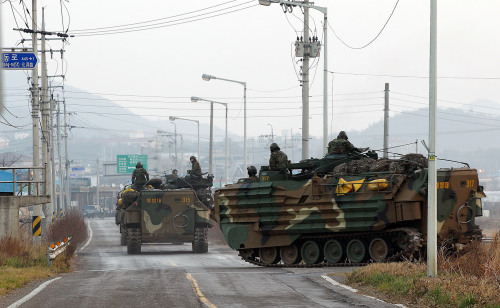South Korea and the U.S. staged a naval exercise to enhance their abilities to stop the trafficking of weapons of mass destruction on Tuesday, the third day of their four-day exercise in the West Sea.
“Under the scenario in which a ship suspected of carrying WMDs is caught passing at high seas, the allied militaries will practice sharing intelligence on the ship and sending warships to interdict the vessel,” said an official at the Joint Chiefs of Staff in a press briefing.
“It is a high-level tactical drill. We are to mobilize Lynx helicopters to check the maritime situation and keep vigilance while deploying high-speed naval ships and maritime special troops to seize and search the suspicious vessel.”
The joint maneuvers to end Wednesday were widely seen as a move to pressure North Korea, which bombarded the South Korean border island of Yeonpyeong on Tuesday last week, killing four South Koreans including two civilians.
The allied militaries, however, claim the exercise is the latest in a series of the joint drills designed to send a clear warning message to the communist state, which sank the corvette Cheonan in March, killing 46 sailors.
“Under the scenario in which a ship suspected of carrying WMDs is caught passing at high seas, the allied militaries will practice sharing intelligence on the ship and sending warships to interdict the vessel,” said an official at the Joint Chiefs of Staff in a press briefing.
“It is a high-level tactical drill. We are to mobilize Lynx helicopters to check the maritime situation and keep vigilance while deploying high-speed naval ships and maritime special troops to seize and search the suspicious vessel.”
The joint maneuvers to end Wednesday were widely seen as a move to pressure North Korea, which bombarded the South Korean border island of Yeonpyeong on Tuesday last week, killing four South Koreans including two civilians.
The allied militaries, however, claim the exercise is the latest in a series of the joint drills designed to send a clear warning message to the communist state, which sank the corvette Cheonan in March, killing 46 sailors.

Observers said that the interdiction drill appears designed to practice preventing North Korea’s WMDs such as fissile materials, missiles, and chemical and biological weapons from getting into the wrong hands outside the peninsula in the event of a sudden change or instability in the reclusive regime.
Some critics argued that it was inappropriate to conduct the interdiction drill, which is similar to U.S.-led Proliferation Security Initiative activities, as part of an exercise designed to deter North Korean provocations.
“When we conducted the joint exercise in the East Sea in July, we also carried out the drill to interdict vessels suspected of carrying WMDs. This drill was planned from the very start when we began talking about the joint exercise,” a JCS official told reporters.
Some, however, claimed that the allied militaries appear to have included the interdiction drill as part of the joint exercise because a separate PSI exercise could prompt resistance from neighboring countries such as China and North Korea.
The Ministry of National Defense said, “The PSI exercise is an international one with the participation of PSI signatories to prevent the illegal spread of the weapons of mass destruction in accordance with the international and domestic laws, while the interdiction drill ― aimed at protecting national security ― is in the form of an operation that the Navy carries out during peace and war time.”
The PSI was first started in 2003 by former U.S. President George W. Bush as a program that calls on signatories to search suspicious ships passing through their waters. Last year, following the North’s second nuclear test in May, South Korea joined the PSI, becoming the program’s 95th member.
Aegis-equipped destroyers, frigates and other naval vessels were mobilized for the drills.
The allied militaries also continued their aerial defense exercise, carrier assault operations and other maritime offensive and defensive drills with more military assets deployed than the previous day.
“Today’s exercise focuses on more practical and high-level tactical operations rather than focusing on getting acquainted with the exercise procedures,” another JCS official said. “Through the exercise, we will maximize our interoperability and joint operational capabilities to immediately respond to a variety of enemy provocations.”
During the exercise, the U.S. military deployed the 97,000-ton nuclear-powered aircraft carrier USS George Washington, the 9,600-ton guided-missile cruiser USS Cowpens and other guided-missile destroyers ― USS Shiloh, USS Stethem and USS Fitzgerald. It also deployed four F-16Cs and A-10C attackers.
The South Korean military deployed the 7,600-ton KDX-III Aegis-equipped destroyer King Sejong the Great, two 4,500-ton KDX-II destroyers, several frigates, corvettes and logistical support ships, four F-15Ks and four KF-16s and P3-C antisubmarine aircraft.
By Song Sang-ho (sshluck@heraldcorp.com)








![[Graphic News] More Koreans say they plan long-distance trips this year](http://res.heraldm.com/phpwas/restmb_idxmake.php?idx=644&simg=/content/image/2024/04/17/20240417050828_0.gif&u=)
![[KH Explains] Hyundai's full hybrid edge to pay off amid slow transition to pure EVs](http://res.heraldm.com/phpwas/restmb_idxmake.php?idx=644&simg=/content/image/2024/04/18/20240418050645_0.jpg&u=20240419100350)





![[From the Scene] Monks, Buddhists hail return of remains of Buddhas](http://res.heraldm.com/phpwas/restmb_idxmake.php?idx=652&simg=/content/image/2024/04/19/20240419050617_0.jpg&u=20240419175937)

![[KH Explains] Hyundai's full hybrid edge to pay off amid slow transition to pure EVs](http://res.heraldm.com/phpwas/restmb_idxmake.php?idx=652&simg=/content/image/2024/04/18/20240418050645_0.jpg&u=20240419100350)

![[Today’s K-pop] Illit drops debut single remix](http://res.heraldm.com/phpwas/restmb_idxmake.php?idx=642&simg=/content/image/2024/04/19/20240419050612_0.jpg&u=)